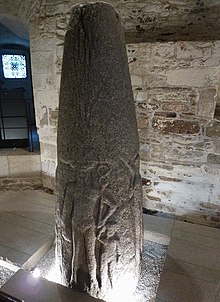Stele of Kervadol
The Gallic stele of Kervadol (also called the stele of Plobannalec ) is now in the Musée départemental breton in Quimper in the Finistère département in Brittany in France .
The Iron Age stele dates from the 4th or 5th century BC. In the Gallo-Roman period it was decorated with reliefs showing four deities. It was found in 1878 in a field near the hamlet of Kervadol , about one kilometer south of Plobannalec . Paul du Châtellier (1833–1911) had them set up at the Château de Kernuz .
The representations on the four sides of the 2.85 m high menhir are interpreted as Mercurius (accompanied by a deceased or by Cupid ), Hercules , Mars and Apollon (accompanied by a female figure, possibly Hygieia / Sirona ).
- Stele of Kervadol
The Kervadol dolmen and the Kervignon dolmen are located near the original location of the stele .
literature
- Paul du Châtellier: Menhir-autel de Kernuz , in: Bulletin de la Société d'Emulation des Côtes-du-Nord , 1878, pp. 125-140.
- Jean-Yves Éveillard: Un monument sculpté gallo-romain atypique: La stèle de Kervadol en Plobannalec (Finistère) , in: Bulletin de la Société Archéologique du Finistère , Volume 133 (2004), pp. 43-59.
Web links
- Musée départemental breton: Pierre dite "aux quatre Dieux" de Kervadol (French)



